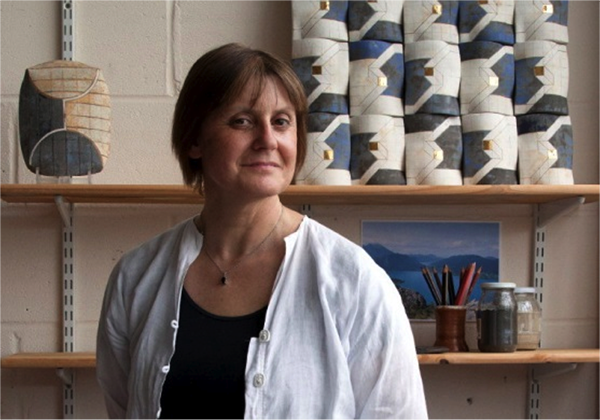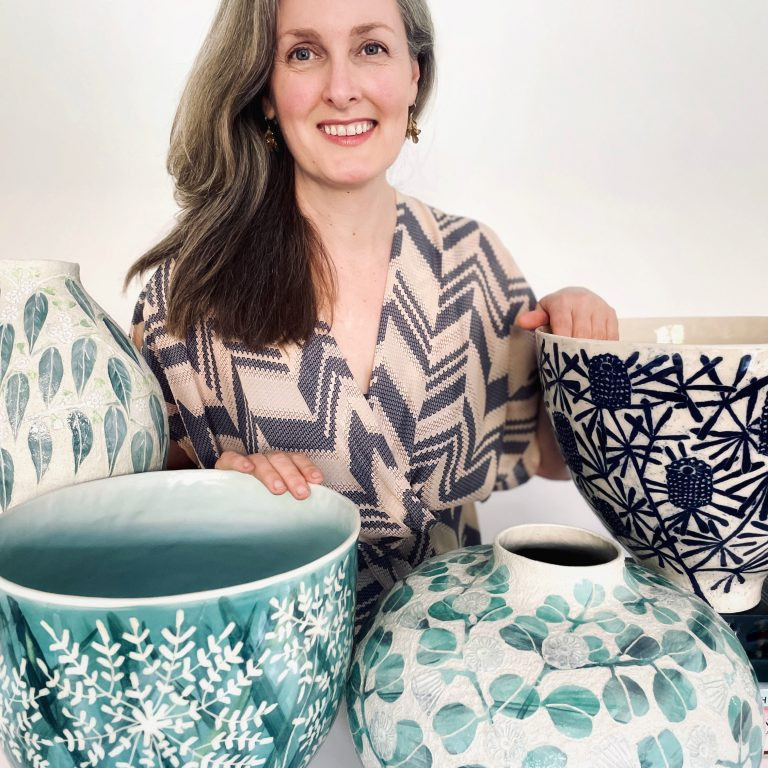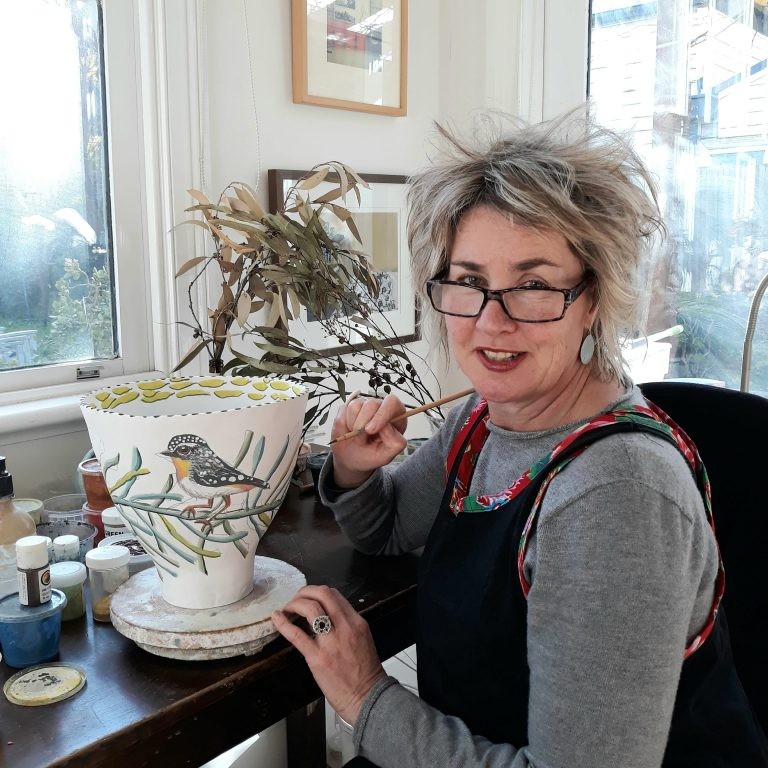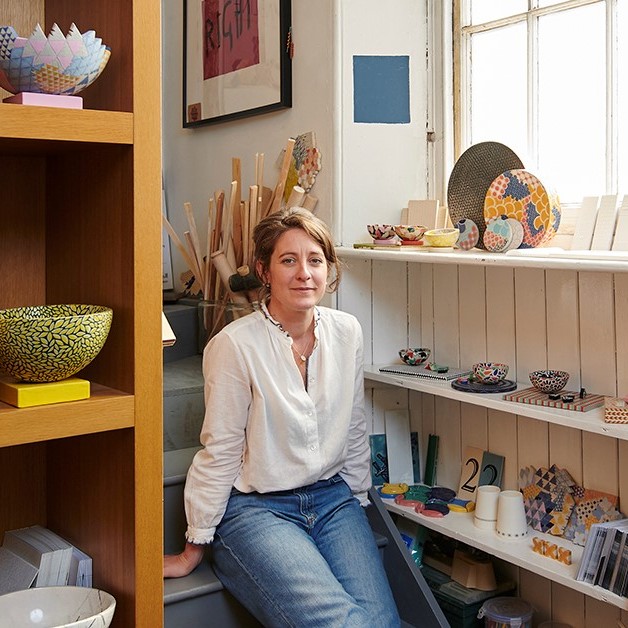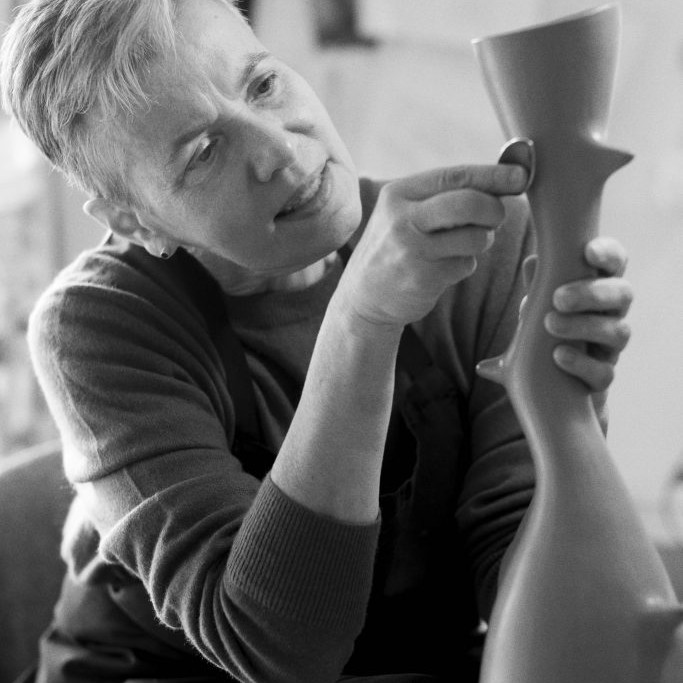Regina Heinz Ceramic Artist - London, UK
You have done many residencies in the UK and beyond. Can you expand on the importance of them to you work?
Residencies are a great opportunity to push the boundaries of one’s work. They provide time, space and usually good facilities and thus encourage to experiment, try a different scale or introduce a new technique.
All my residencies have worked in this way. Two of them were particularly beneficial: At the beginning of my career I spent three months at Cleveland Crafts Centre, Middlesbrough, England and in 2011 I was invited as part of the British contingent to create work for the Fule International Ceramic Museum in Fuping, China.
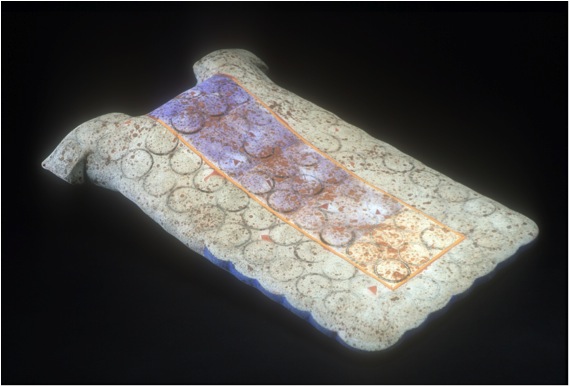
‘Dress’ Brushed Lithium Glaze, Middlesbrough
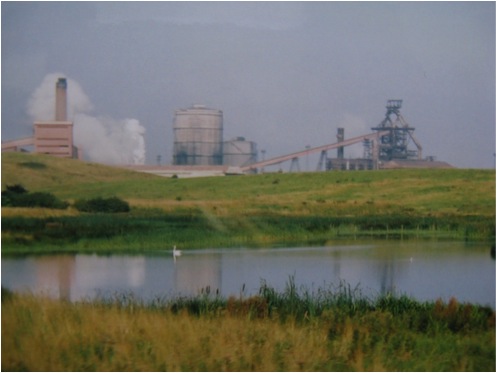
‘Middlesbrough’’
Middlesbrough is an industrial town in the North East of England not far from the lovely rolling landscape of the Yorkshire Moors. I was startled by the stark contrast created by industrial plants eating into the natural environment. This prompted me to “cut” into my organic pillow shapes and to introduce “manmade” right angled elements in order to visualise this contrast.
Since then I have cultivated this contrast. Balance and juxtaposition of precise geometric components and softly undulating sensual forms is one of the main characteristics of my visual language.
The residency in Fuping took place in a brick factory and not only provided a huge working space but also the opportunity to work with prefabricated elements.
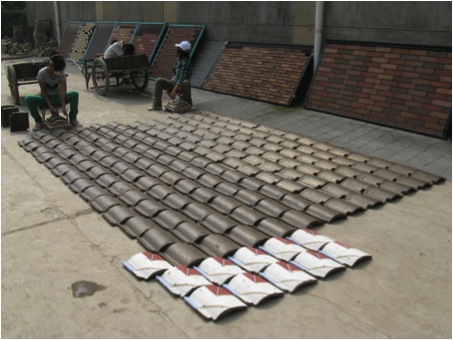
‘Fuping Residency’ – New Roof
The factory produced curved roof tiles amongst other products. I used 70 of them to create the large relief sculpture “A New Roof”, displayed on the floor of the British pavilion. This sparked off ideas of creating my recent body of large scale wall based work, 3D undulating wall units, cast in Stoke on Trent, hand painted in my South London studio, which can be combined in different ways to create installations for interior and exterior settings.
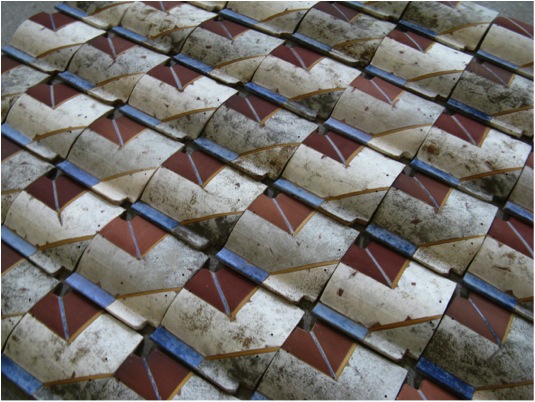
New Roof- detail
Are there any special tricks to winning residencies that you are willing to share?
It is always good to indicate why you are applying how and in what way the residency will benefit your work. Usually residencies have certain criteria when looking for in suitable candidates. If you want to apply find out as much as possible about the residency and in your application try to fit the criteria.
Exhibiting of you ceramics: how, where and why?
Exhibiting and selling my work is a form of communicating and thus vital for my professional life. I am grateful to have been able to exhibit in many different venues all over the world, including galleries, competitions, museums exhibitions and ceramic and interior design fairs. All these venues demand different types of work and target a different audience, one off pieces and special pieces are best exhibited in galleries and museums, my recent wall based work also fits the criteria of architectural ceramics and has been successfully exhibited in interior design fairs over the past years.
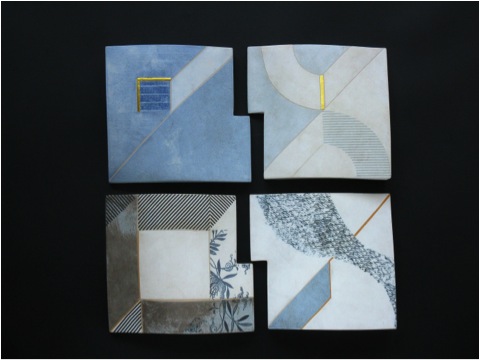
Architectural Ceramics ‘Collection Flow’
Your initial training was in painting. Can you explain how this can be seen in your current work?
All my work is essentially painting onto a 3-D surface. I love colour in general and the richness depth and texture of ceramic colour in particular. I also love the act of brushing and when decorating I am building up layers of colours and textures.
Oxides, glazes, biscuit slips, washes of ceramic pigment and most recently ceramic transfers and gold enamels are applied in sequence and juxtaposed and very often fired on in between in multiple firings, thus creating depths and vibrancy which adds to the richness and sensuality of the organic form. Bits of the layer underneath are very often left exposed thus emphasising the act of painting.
Most recently in my high firing range I have discovered shades of colour and natural phenomena like a sunlit moving water surface are translated into a ”carpet” of different coloured tones, golden highlights and bold patterns.
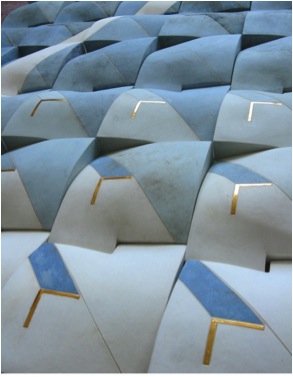
‘Flow Collection ’ Brushed Stoneware Glaze
We see a lot of rhythm and repetitive pattern work, please discuss?
As with my colour palette also my patterns have been derived from nature and observation of natural phenomena.
The movement of water is one of my main sources of inspiration and is translated into undulating forms and wavy repetitive patterns and designs.
Over the years my focus on the landscape has undergone an interesting change. Overall views have been submitted to a process of “zooming in” and “blowing up” of smaller and smaller areas. Close ups of surfaces, details of natural and manmade environments now serve as starting points.
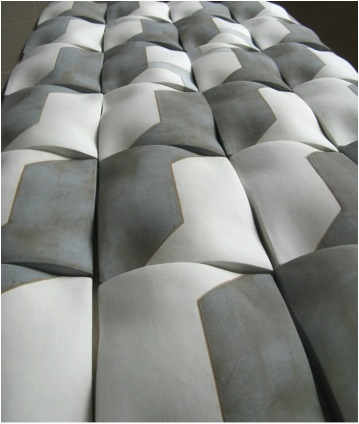
‘Cityscape’ each tile 20x15x3cms
Your work is hand built. Can you expand on your technique?
All my hand built work is constructed from soft slabs in order to emphasise the sensual and tactile qualities of clay.
The process can be compared to “tailoring”, the designs are developed on a flat surface, then slabs are rolled out, cut and incised similar to pattern cutting. The slabs are shaped while still soft by gentle pressure applied from above or underneath to create an undulating surface. I always try to manipulate the slabs as little as possible and to retain their original surface texture, cracks, markings, newspaper creases etc. to the highest possible degree. This technique is paramount to my work and requires both spontaneity and control. The soft slabs react immediately to every touch, every movement of the hand and are easily over-worked, in danger of losing their elasticity and freshness.
When leather hard the slabs are joined to form a 3D object. This is the most exciting stage in the making process and results in a piece which unifies colour, form, texture and design.
I use grogged Stoneware clays for technical and aesthetic reasons. Grog provides tactile and visual texture as well as strength for better control during the forming process.
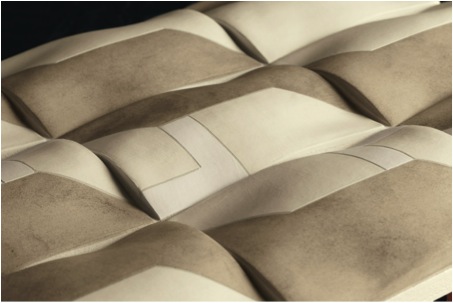
‘Cityscape Collection’
Can you explain about both your studio and the importance of an arts grant to help you set it up?
Maintaining a professional studio is an essential part of working as a ceramic artist.
I received a setting up grant from the British Crafts Council when I started out. The help was invaluable, I was able to equip my studio with a proper kiln, pug mill and slab roller and turn it into a functioning ceramic studio. The grant also kick started my career as my work was included in the promotional campaign run by the Crafts Council for all the grants recipients.
Your work is suitable for internal and external display. Can you explain how these differ?
I have two firing and glaze ranges.
The decoration of my low firing indoor range consists of a Lithium glaze fired to 1035°C and various oxides, washes of ceramic pigments and biscuit slips.
The final effect is the result of multiple firings; layers of colour are fired-on between applications.
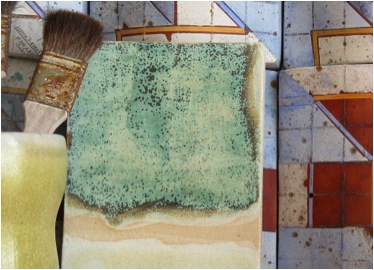
The high firing range uses a stoneware glaze with a high China clay content that generates a beautiful mat fresco like surface, well suited to “clothe” the organic undulating forms. Oxides and stains are added in varying quantities to achieve shades of colour. My high firing colour palette comprises warm tones, browns and ochre as well as blues, greens and greys.
How are your wall sculptures physically hung?
The wall sculptures are mounted on boards, either glued for a permanent fixture or screwed on using cavity screws for a non-permanent installation.
If required the modules can also be glued permanently to the wall using a tile adhesive.
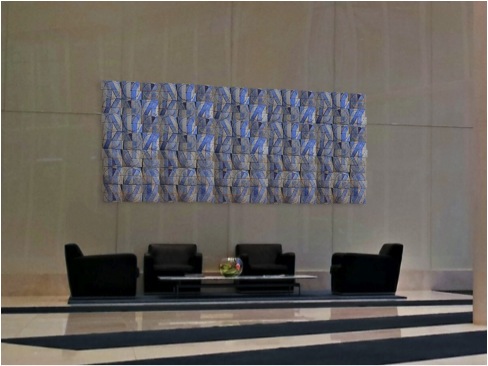
‘Flow’ 300 x 140 x 5 cm
Colour and pattern is intrinsically part of your work. Please expand on this?
The Austrian painter Gustav Klimt is very well known for his highly decorative and ornamented art nouveau portrait paintings of high society ladies in Vienna around 1900.
Perhaps less well known are his beautiful landscape paintings he created during several summers when he stayed on the lake “Atter” (Attersee) in “Salzkammergut”, Upper Austria, the same lake where I used to stay during my child hood summers.
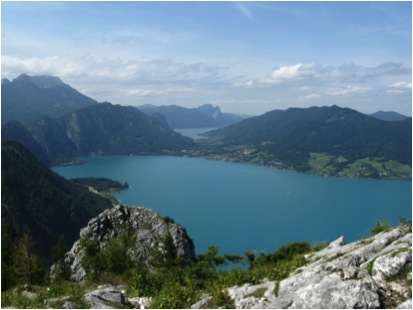
Lake Attersee, Upper Austria
I particularly love the paintings which depict the lake. Though observed from nature the different shades of blue and turquoise of the water surface are represented by single brush strokes in different colours, which when looked at in isolation, remind me of abstract paintings. The visual impression of glittering light, reflection and movement has been translated into tessellations of colour, very similar to the process I am using in my work: Observation from nature are simplified, abstracted and distilled into colour, patterns and forms.
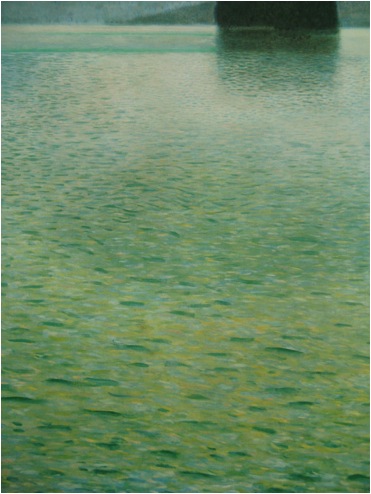
Water Surface Island Donthe, Lake Attersee
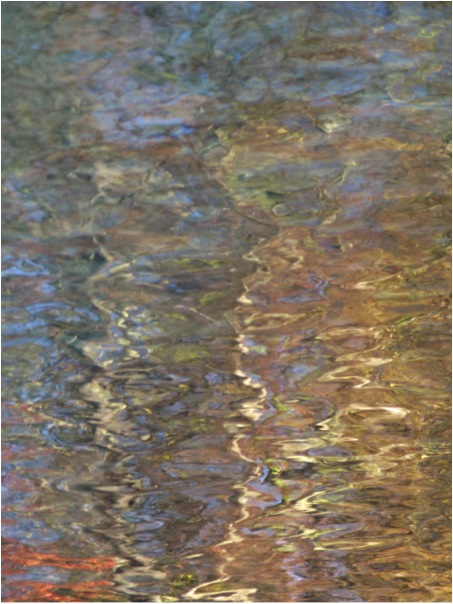
Water surface – inspiration for ‘Flow’
What are the sizes of your work?
I love to work in groups or to themes, large scale, and for particular sites Therefore depending on the circumstances or commissions there are no size restrictions. My sculptures start from usually 30 cm, my largest free standing sculpture so far was 160 cm high, restricted only by the size of the available kiln.
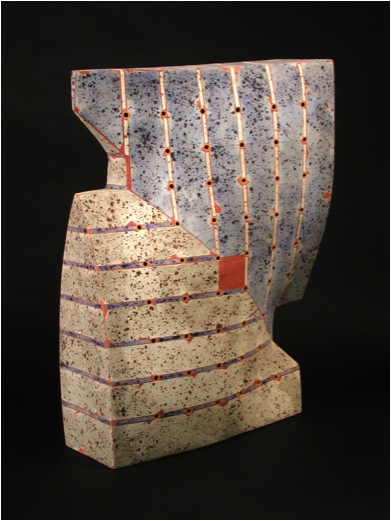
‘With a Twist’ 63x55x30 cms
The modular nature of my wall based work lends itself to large scale and can easily be extended to whole interior or exterior walls. The largest piece so far was 2 x 2 m and was created for an exhibition display for the American company Ann Sacks.
You comment that you get inspiration from the mountainous landscape of your homeland, Austria, how?
My work is biographical and topographical and draws from my early memories of growing up in a particular beautiful mountainous part of Austria. Rather than telling stories and incorporating a narrative I am conveying my feelings and visual impressions in a more abstract way and encourage the spectator to create their own stories and memories. Very often I use the camera as a vehicle to explore my surroundings. Photography is part of my creative process, with the image abstracted, tessellated and integrated into softly undulating ceramic forms. Like photographs my pieces are impressions, “3-D snapshots” that capture moments in time.
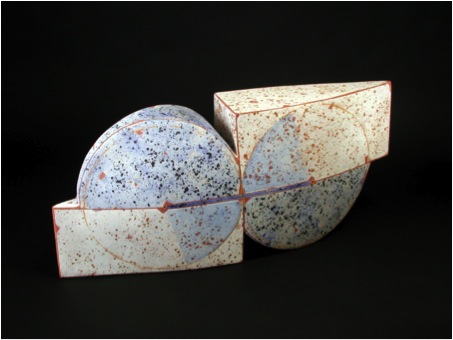
‘Engaged’
You have your work in many UK and international galleries. Can you explain how you have been able to develop this network and also how you keep up with the work load?
I am a member of several professional associations including the British Crafts Council, the British Craft Potters Association and the International Academy of Ceramics. This helps with networking, getting to know key figures in the ceramics world and obtaining important information regarding galleries, exhibition opportunities, competitions etc. I have also always proactively researched and applied to suitable galleries, presented my work at fairs and most recently started a newsletter sent to my contacts on a regular basis. In general I try to “communicate” my work through exhibitions, publications, competitions and taking part in workshops and symposia. In 2011 I demonstrated at the International Ceramic Festival in Aberystwyth, which also has greatly extended my network.
As to the work load it is important to be organised, to plan ahead and to prioritise the most important events. Occasionally I also employed an assistant and had help in the studio from students and interns.
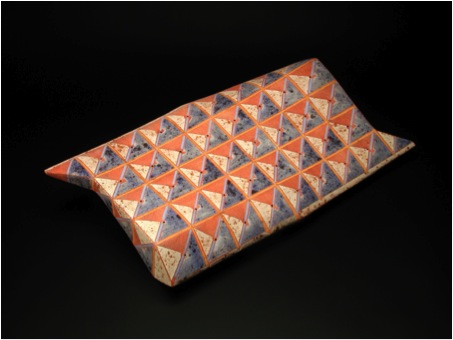
‘Keeping Time’
You have had to develop a way of packing and freighting you work around the world. This would often be a problem that stops other new ceramic artists, can you share some of the secrets?
Shipping is not really a problem. There are now very good online shipping companies available who offer competitive rates all over the world.
The real secret is packing. I had very few breakages over the years. One has to allow for plenty of space around the piece filled with protective fillers like polystyrene. Using double boxes is also very good and in general packed like that the piece will arrive safely and sound.
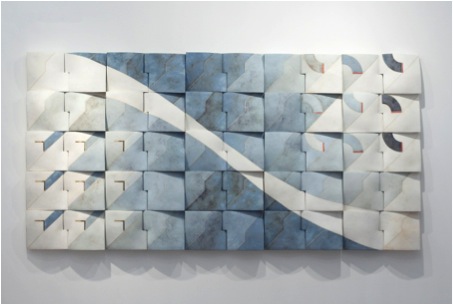
‘Flow’
Your work is in many collections, can you take one or two that have given you particular delight and why?
It gives me great pleasure to know that my work can be found all over the world. Two collections stand out:
One is the private collection in California. Paul F. Dauer is an enthusiastic and knowledgeable collector of British studio ceramics, and I am very proud to be part of this fine collection.
The second one is Museum of Modern Ceramic Art, Gifu, Japan. Two of my ceramic sculptures were added to the collection this year. Created in 2000 the museum focuses on modern ceramic art and aims to represent both functional and non-functional international ceramic art in a beautiful setting, making it to one of the finest ceramic art museum worldwide.
What are you currently working on?
My most exciting project at the moment is designing panels to be included in the art work for a large cruise ship. Apart from developing new designs, patterns and shapes the project also involves working with the architect, managing suppliers and being involved in the whole process right from start, all of which is an exciting new departure.
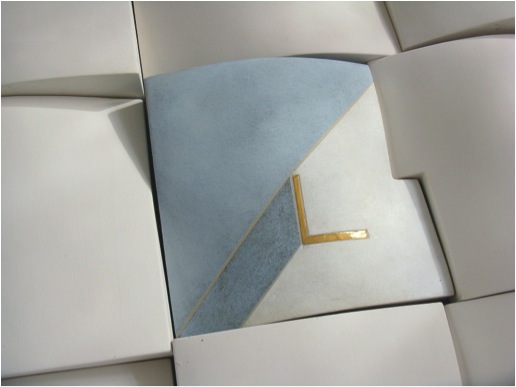
‘Flow’ detail
Contact Details
Regina Heinz, London, UK
Interview by Deborah Blakeley, October, 2013
Think a colleague or friend could benefit from this interview?
Knowledge is one of the biggest assets in any business. So why not forward this on to your friends and colleagues so they too can start taking advantage of the insightful information the artist has given?
Other artists you may be interested in:


